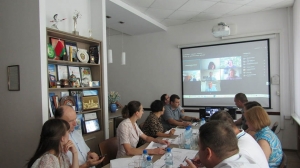IAEA to evaluate Belarus' nuclear, radiation safety in December

MINSK, 15 July (BelTA) – The International Atomic Energy Agency's post-mission of the Integrated Regulatory Review Service (IRRS) will evaluate Belarus' nuclear and radiation safety regulatory infrastructure in December 2021, representatives of the Nuclear and Radiation Safety Department of the Belarusian Emergencies Ministry (Gosatomnadzor) told BelTA.
Gosatomnadzor and IAEA representatives arranged a preparatory meeting ahead of the IRRS post-mission on 13-14 July. The meeting was organized as a videoconference. During the meeting the sides discussed various aspects of preparations for the IRRS post-mission, determined the format, the timeline for the visit and the steps that need to be taken before the post-mission arrives.
The primary goal of the forthcoming IRRS post-mission will be to review the fulfillment of recommendations and proposals of the IRRS mission that visited Belarus in 2016. The IRRS post-mission will be led by Deputy Director of the Swiss Federal Inspectorate for Nuclear Safety (ENSI) Georg Schwarz.
During the preparatory meeting Gosatomnadzor presented information about the main changes that have happened since 2016 in areas of interest for the IRRS mission. The sides discussed the preliminary itinerary and the format of the IRRS post-mission. They decided that the mission will work in Belarus on 5-13 December 2021 and will visit the Belarusian nuclear power plant site. Two months before the visit the Belarusian side will provide the relevant materials to the mission's experts for preliminary studies.
The organization of the IRRS post-mission will continue Belarus' consistent steps to invite international evaluation missions and peer reviews, which results are used to further improve the country's nuclear and radiation safety infrastructure and its individual components on the basis of the International Atomic Energy Agency's recommendations and the best international practices.
According to Gosatomnadzor, an IRRS mission visited Belarus in 2016. Over 20 experts led by Petteri Tiippana, Director General of the Finnish Radiation and Nuclear Safety Authority (STUK), came to Belarus to thoroughly examine the country's regulatory infrastructure and the country's work for compliance with the International Atomic Energy Agency's recommendations. The IRRS experts concluded that a regulatory infrastructure for nuclear and radiation safety had been created in Belarus. Solid adherence to realizing nuclear and radiation safety principles was demonstrated during the visit. The experts noticed two positive practices and formulated 25 recommendations and 20 proposals on further improvement of the regulatory infrastructure of nuclear and radiation safety and its individual components. The recommendations and proposals were used to work out the relevant national action plan. The IRRS mission's report is available to the general public on the Gosatomnadzor website.













